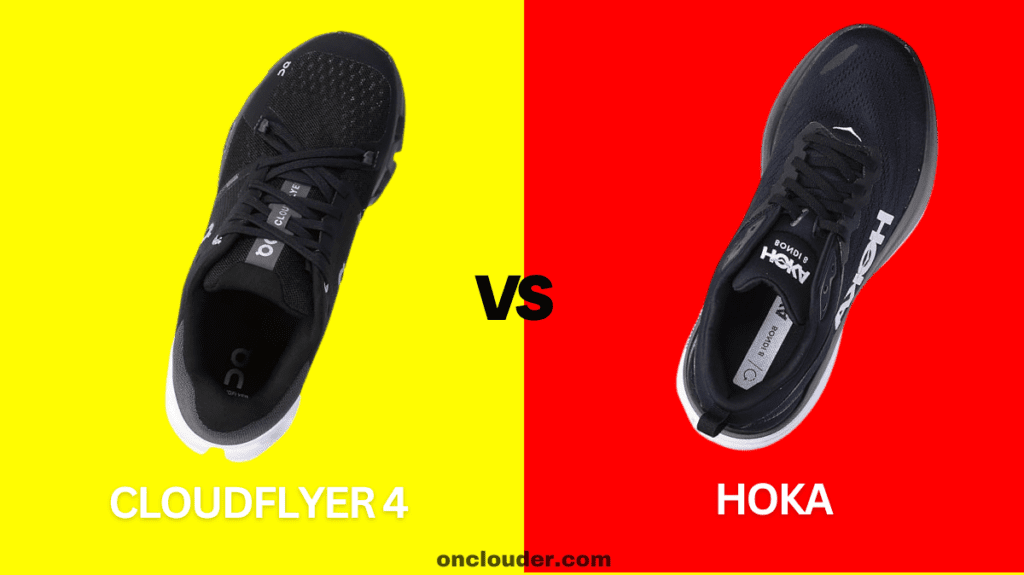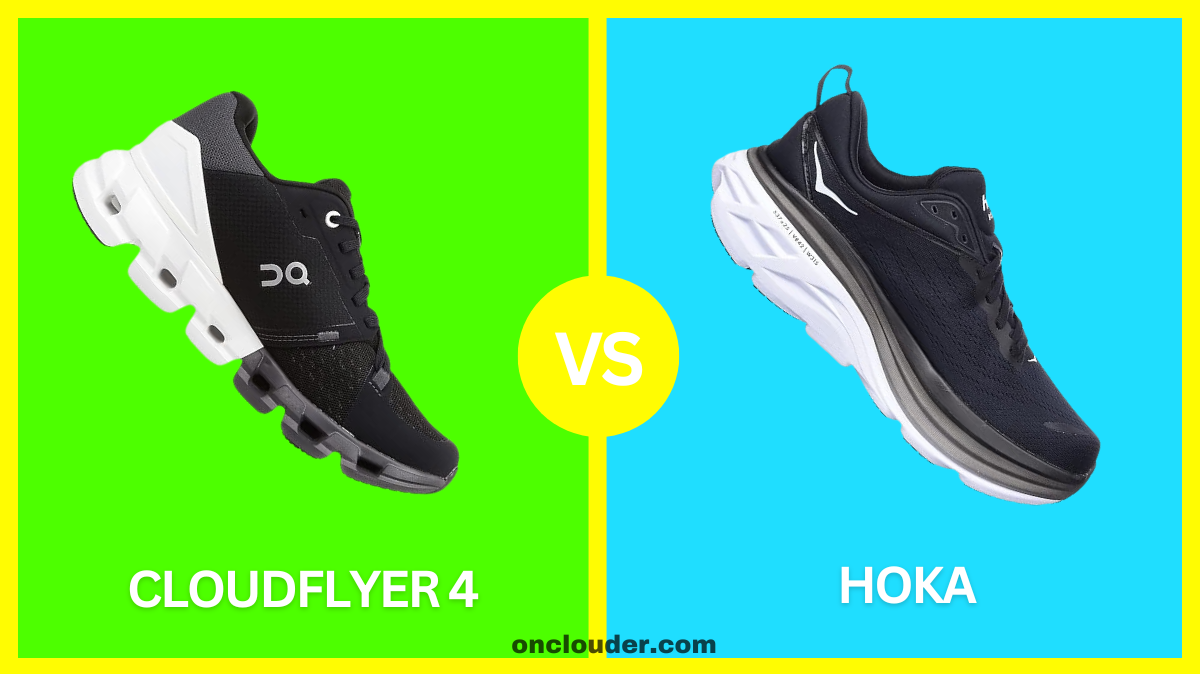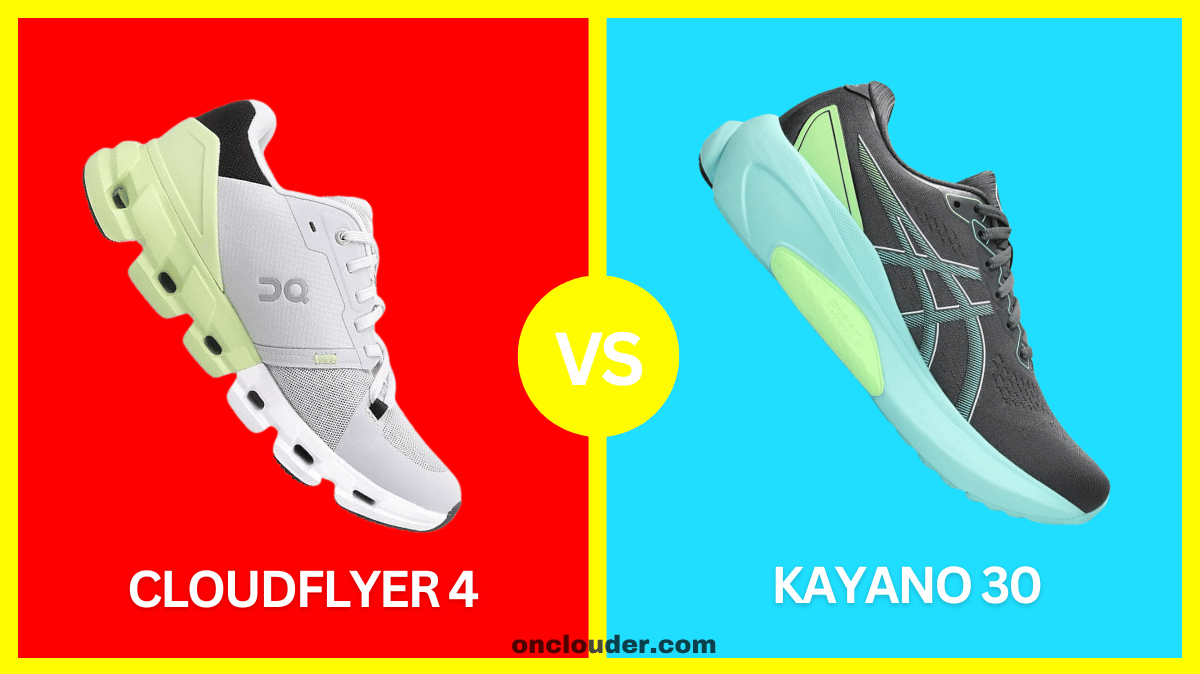Hey there, young runners and shoe enthusiasts! Are you looking for the perfect pair of shoes to keep your feet happy and comfy?
Well, you’re in luck because today we’re going to talk about two awesome shoe brands: Cloudflyer 4 and Hoka. We’ll compare these shoes and help you figure out which one might be best for you.
So, let’s lace up and get started!

Contents
- 1 Quick Comparison: Cloudflyer 4 vs Hoka Shoes
- 2 What Makes These Shoes Special?
- 3 Durability: Built to Last?
- 4 Breathing: Keeping Your Feet Cool
- 5 Cushioning: Softness for Your Soles
- 6 Shoe Fit: Finding Your Perfect Match
- 7 Stability: Keeping You Steady
- 8 Comfort: Happy Feet, Happy You
- 9 Quality: Built to Impress
- 10 Style: Looking Good on the Run
- 11 Size: Finding the Right Fit
- 12 Material: What Are They Made Of?
- 13 Weight: Light as a Feather?
- 14 Flexibility: Bend and Flex
- 15 Water Resistance: Staying Dry
- 16 Sole: The Foundation of the Shoe
- 17 User Reviews and Ratings
- 18 Price Comparison
- 19 Pros and Cons
- 20 Conclusion
- 21 Frequently Asked Questions
Quick Comparison: Cloudflyer 4 vs Hoka Shoes
The main difference between Cloudflyer 4 and Hoka shoes is in their cushioning design. Cloudflyer 4 uses special cloud-like pods on the bottom for a bouncy feel, while Hoka shoes have super thick, soft soles that feel like pillows for your feet.
Both shoes are comfy, but they feel different when you run or walk in them.
Now, let’s create a detailed comparison table for Cloudflyer 4 vs Hoka shoes:
| Feature | Cloudflyer 4 | Hoka Shoes |
| Cushioning | Cloud pods for bounce | Thick, soft foam for maximum cushion |
| Weight | Lightweight (about 10 oz) | Varies, often similar to Cloudflyer 4 |
| Stability | Good stability features | Varies by model, some very stable |
| Breathability | Mesh upper for good air flow | Breathable upper, may vary by model |
| Style | Sleek, modern look with visible pods | Chunky look with very thick soles |
| Best for | Runners who like a bouncy, stable feel | Runners who want lots of soft cushioning |
| Price Range | $160 – $180 | $130 – $180 |
| Durability | Good, with tough materials | Good, especially in high-wear areas |
| Fit | Snug in heel and midfoot, roomy toe box | Often roomy, especially in toe box |
In summary: Cloudflyer 4 and Hoka shoes are both great for running, but they feel different on your feet. Cloudflyer 4 has bouncy cloud pods and feels light and springy.
Hoka shoes have super thick soles that feel super soft and cushiony. Both are comfy, but Cloudflyer 4 might feel more responsive, while Hoka might feel more pillowy. The best choice depends on what feels good to you when you run or walk!
Also Read: Cloudflyer 4 vs Cloudrunner 2
What Makes These Shoes Special?
Before we dive into the details, let’s talk about what makes Cloudflyer 4 and Hoka shoes stand out from the crowd.
Cloudflyer 4: The Swiss Wonder
Cloudflyer 4 shoes are made by a company called On Running. They’re from Switzerland, a country known for its beautiful mountains and tasty chocolate. These shoes are famous for their unique cushioning system that looks like little clouds on the bottom of the shoe. Cool, right?
Hoka: The Comfy Giant
Hoka shoes, on the other hand, come from a brand that started in France. They’re known for their super thick, cushiony soles that make you feel like you’re walking on marshmallows. Hoka has a lot of different shoe models, so we’ll be talking about their popular running shoes in general.
Durability: Built to Last?
When you buy a pair of shoes, you want them to last a long time, right? Let’s see how these shoes hold up.
Cloudflyer 4 Shoes
Cloudflyer 4 shoes are pretty tough. They use strong materials that can handle a lot of running and walking. The special cloud pods on the bottom are made to last, so you don’t have to worry about them wearing out quickly.
Hoka Shoes
Hoka shoes are also built to be durable. They use sturdy materials in their shoes, especially in high-wear areas like the soles. Many runners say their Hoka shoes last for hundreds of miles of running.

Breathing: Keeping Your Feet Cool
Nobody likes sweaty, stinky feet! Let’s see how these shoes help keep your feet fresh.
Cloudflyer 4 Shoes
The Cloudflyer 4 has a breathable upper part made of mesh. This means air can flow in and out, helping to keep your feet cool and dry. It’s like having tiny windows for your feet!
Hoka Shoes
Hoka shoes also use breathable materials in their uppers. Many of their shoes have mesh or knit fabrics that let air circulate. Some Hoka models even have extra ventilation holes to keep your feet extra cool.
Cushioning: Softness for Your Soles
Good cushioning can make running and walking more comfortable. Let’s see how these shoes cushion your feet.
Cloudflyer 4 Shoes
Remember those cloud-like pods we talked about? They’re not just for looks! These pods compress when you step down and then spring back when you lift your foot. This gives you a soft landing and a bouncy takeoff.
Hoka Shoes
Hoka is famous for its thick, soft cushioning. Their shoes often have a lot of foam in the midsole, which is like having a pillow under your feet. This can be great for long runs or if you have sore feet.
Shoe Fit: Finding Your Perfect Match
Getting the right fit is super important for comfort and preventing blisters. Here’s how these shoes fit.
Cloudflyer 4 Shoes
Cloudflyer 4 shoes are designed to fit snugly in the heel and midfoot, with a bit more room in the toe box. This means they hug your foot to keep it stable, but your toes have space to wiggle.
Hoka Shoes
Hoka shoes often have a roomy toe box, which is great if you have wider feet. The fit can vary between different Hoka models, so it’s a good idea to try them on if you can.
Also Read: Cloudflyer 4 vs Cloudflyer 3
Stability: Keeping You Steady
Stability in a shoe helps prevent your foot from rolling inward too much when you run or walk. This can be important for some people to avoid injuries.
Cloudflyer 4 Shoes
The Cloudflyer 4 is designed as a stability shoe. It has features like a wider base and firmer foam on the inner side of the shoe to help keep your foot aligned.
Hoka Shoes
Hoka offers both neutral and stability shoes. Their stability models often have a firmer piece of foam on the inner side of the heel to help control excessive inward rolling of the foot.

Comfort: Happy Feet, Happy You
Comfort is king when it comes to shoes. Let’s see how comfy these shoes are.
Cloudflyer 4 Shoes
Many runners find the Cloudflyer 4 very comfortable, thanks to its cloud-like cushioning and snug fit. The shoe is designed to feel good right out of the box, without needing a long break-in period.
Hoka Shoes
Hoka shoes are known for their extreme comfort, especially for people who spend a lot of time on their feet. The thick cushioning can feel like walking on clouds to some people.
Quality: Built to Impress
Quality is about how well the shoe is made and the materials used. Both brands pride themselves on making high-quality shoes.
Cloudflyer 4 Shoes
On Running, the company behind Cloudflyer, uses premium materials and pays attention to small details. The shoes are well-constructed and designed to handle lots of use.
Hoka Shoes
Hoka also uses high-quality materials in their shoes. They’re constantly innovating and improving their designs to make better shoes.
Style: Looking Good on the Run
While how a shoe performs is most important, it’s also nice if it looks cool. Let’s talk about style!
Cloudflyer 4 Shoes
Cloudflyer 4 shoes have a unique look thanks to their cloud pods. They come in several color options, from simple white or black to brighter colors. The design is sleek and modern.
Hoka Shoes
Hoka shoes have a distinctive chunky look due to their thick soles. They come in a wide range of colors and designs, from subtle to very bright and eye-catching.
Also Read: Cloudflyer 4 vs Kayano 30
Size: Finding the Right Fit
Getting the right size is crucial for comfort and performance. Here’s what you need to know about sizing for these brands.
Cloudflyer 4 Shoes
Cloudflyer 4 shoes generally run true to size, meaning the size you usually wear in other shoes should fit well. However, if you have wide feet, you might want to go up half a size.
Hoka Shoes
Hoka sizing can vary between models. Some run true to size, while others might run a bit small or large. It’s a good idea to check the sizing recommendations for the specific Hoka model you’re interested in.
Material: What Are They Made Of?
The materials used in a shoe affect how it feels, how long it lasts, and how it performs. Let’s look at what these shoes are made of.
Cloudflyer 4 Shoes
Cloudflyer 4 uses a mix of materials. The upper is made of engineered mesh for breathability. The midsole (the cushiony part) is made of On’s special Helion™ superfoam. The outsole (bottom of the shoe) uses rubber in high-wear areas for durability.
Hoka Shoes
Hoka uses different materials in different models, but many of their shoes have knit or mesh uppers for breathability. Their midsoles are often made of EVA foam or their own blends of foam for cushioning. The outsoles usually use rubber for grip and durability.

Weight: Light as a Feather?
The weight of a shoe can affect how it feels when you run or walk. Lighter shoes can feel faster, but heavier shoes might feel more supportive.
Cloudflyer 4 Shoes
Cloudflyer 4 shoes are relatively lightweight for a stability shoe. A typical pair weighs about 10.2 oz (290g) for men’s size 9 and 8.6 oz (245g) for women’s size 8.
Hoka Shoes
The weight of Hoka shoes can vary quite a bit between models. Some are very lightweight, while others are a bit heavier due to extra cushioning. On average, they tend to be similar in weight to the Cloudflyer 4 or slightly heavier.
Flexibility: Bend and Flex
A flexible shoe can move with your foot, which can make running feel more natural. Let’s see how flexible these shoes are.
Cloudflyer 4 Shoes
The Cloudflyer 4 offers a good balance of flexibility and support. The cloud pods allow the shoe to flex where your foot naturally bends, but the shoe still provides structure where needed.
Hoka Shoes
Hoka shoes vary in flexibility. Some models are quite flexible, while others are stiffer for more support. In general, Hoka shoes tend to be less flexible than the Cloudflyer 4 due to their thicker soles.
Water Resistance: Staying Dry
While neither of these shoes is designed to be waterproof, it’s good to know how they handle a bit of water.
Cloudflyer 4 Shoes
The Cloudflyer 4 isn’t waterproof, but its mesh upper does a decent job of shedding light rain. The shoe drains and dries fairly quickly if it does get wet.
Hoka Shoes
Most Hoka shoes aren’t waterproof either, but like the Cloudflyer, they usually handle light rain okay. Hoka does offer some waterproof models for really wet conditions.
Also Read: Cloudflyer 4 vs Cloudswift
Sole: The Foundation of the Shoe
The sole is super important because it’s the part of the shoe that actually touches the ground. Let’s look at how these soles compare.
Cloudflyer 4 Shoes
The Cloudflyer 4’s sole is its standout feature. It has those unique cloud pods that compress and rebound as you run. The outsole (the very bottom part) uses rubber in high-wear areas for good grip and durability.
Hoka Shoes
Hoka soles are known for their thickness. They often have a curved shape (called a rocker) that can help you roll through your stride more easily. The outsoles usually have a good amount of rubber for grip and durability.

User Reviews and Ratings
Let’s see what other people think about these shoes! Here’s a table showing average user ratings for different aspects of the shoes.
| Aspect | Cloudflyer 4 | Hoka |
| Comfort | ⭐⭐⭐⭐⭐ | ⭐⭐⭐⭐⭐ |
| Durability | ⭐⭐⭐⭐ | ⭐⭐⭐⭐ |
| Style | ⭐⭐⭐⭐ | ⭐⭐⭐⭐ |
| Performance | ⭐⭐⭐⭐⭐ | ⭐⭐⭐⭐⭐ |
| Value | ⭐⭐⭐⭐ | ⭐⭐⭐⭐ |
As you can see, both shoes get pretty high ratings overall!
Price Comparison
Here’s a general idea of what you might expect to pay for these shoes:
| Shoe | Price Range |
| Cloudflyer 4 | $160 – $180 |
| Hoka | $130 – $180 |
Remember, prices can change and may be different depending on where you buy the shoes.
Pros and Cons
| Shoe | Pros ✅ | Cons ⚠️ |
| Cloudflyer 4 | Bouncy feel from cloud pods | Might feel too firm for some people |
| Lightweight and easy to run in | Can be expensive | |
| Good for people who need stable shoes | Limited color choices | |
| Breathable and keeps feet cool | Pods might collect small rocks sometimes | |
| Unique, cool-looking design | Might take time to get used to the feel | |
| Hoka Shoes | Super soft and cushioned | Can feel too squishy for some runners |
| Great for long runs or standing all day | Thick soles might feel weird at first | |
| Lots of different models to choose from | Some people think they look too chunky | |
| Good for people with sore feet or knees | Might not feel very fast or springy | |
| Often good for wider feet | Can be expensive, especially some models |
Conclusion
After all this comparing, you might be wondering which shoe you should choose. The truth is, there’s no one “best” shoe for everyone. It depends on what you like and what feels good on your feet.
If you like a unique-looking shoe with a bouncy feel and good stability, you might love the Cloudflyer 4. It’s a great choice for runners who want a mix of cushioning and responsiveness.
If you want maximum cushioning and don’t mind a chunkier look, Hoka shoes could be perfect for you. They’re awesome for long runs or if you spend a lot of time on your feet.
The best thing to do is try on both if you can. Walk around in them, or even better, run a little if the store lets you. Your feet will tell you which one feels best!
Remember, the most important thing is that your shoes feel comfortable and help you enjoy running or walking. Whether you choose Cloudflyer 4, Hoka, or another brand altogether, the best shoe is the one that makes your feet happy!
Frequently Asked Questions
Are Cloudflyer 4 and Hoka shoes good for beginners?
Yes! Both brands offer shoes that can work well for beginners. Cloudflyer 4 provides good stability which can be helpful when you’re starting out. Hoka’s extra cushioning can be comfy for new runners who aren’t used to the impact of running.
Can I use these shoes for other sports besides running?
While they’re designed primarily for running, many people use these shoes for other activities too. They can be good for walking, gym workouts, or just everyday wear. However, for sports with lots of side-to-side movement like tennis or basketball, you might want a shoe designed specifically for those sports.
How often should I replace my running shoes?
Most experts recommend replacing running shoes every 400-500 miles. This can vary depending on your weight, running style, and the surfaces you run on. If you notice the cushioning feeling flat or see visible wear on the soles, it might be time for new shoes.
Are these shoes good for people with flat feet?
Both Cloudflyer 4 and some Hoka models can be good for flat feet. The Cloudflyer 4 offers stability features that can help with flat feet. Hoka has several models designed for overpronation (which often occurs with flat feet). It’s always best to consult with a podiatrist or running shoe expert for personalized advice.
Can these shoes help with foot pain?
Many people find that well-cushioned shoes like Cloudflyer 4 and Hoka can help with foot pain. However, persistent foot pain should be checked by a doctor. The right shoe can help, but it’s not a cure-all for foot problems.




